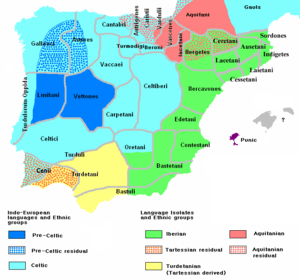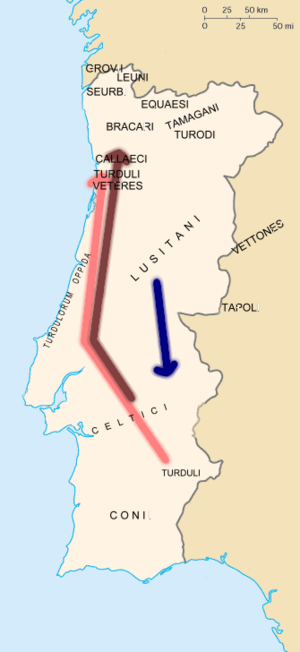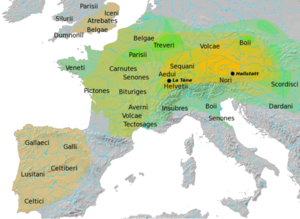Celtici facts for kids
The Celtici were an ancient group of people who lived in the Iberian peninsula, which is where modern-day Portugal and Spain are located. They were part of the larger Celtic family. You could find them in three main areas:
- In what is now the Alentejo and Algarve regions of Portugal.
- In parts of Spain, specifically the Province of Badajoz and north of the Province of Huelva, in an old region called Baeturia.
- Along the coast of Galicia in Spain.
Ancient writers like Strabo and Pliny wrote about the Celtici. They described how the Celtici were connected to other groups like the Gallaeci, Celtiberians, and Turdetani.
Contents
Who Were the Celtici?
Ancient Greek and Roman writers often mentioned the Celtici. For example, Strabo, a Greek geographer, said that the Celtici were the main people living between the Tagus and Guadiana rivers, which is now the Alentejo region of Portugal.
The Celtici were seen as a civilized people, much like their neighbors, the Turdetani. Strabo noted that they shared a "gentle and civilized" way of life. However, he also mentioned that the Celtici often lived in smaller villages or hamlets, unlike the Turdetani who had larger cities.
Some of their important cities included Lacobriga (likely Lagos), Miróbriga (near Santiago do Cacém), and Ebora (modern Évora). They also had cities like Nertobriga, Turobriga, and Segida.
The Celtici played a big part in spreading Celtic culture to the Conii people in the Algarve region. Their most famous city was Conistorgis. Strabo also said that the Celtici founded colonies, like Pax Julia (modern Beja).
Where Did They Come From?
According to Pliny, a Roman writer, the Celtici who lived in Baeturia (a region in Spain) came from the Celtici of Lusitania (a region in Portugal). He believed they were related to the Gallaeci people as well.
Pliny thought that all the Celtic people in the Iberian Peninsula, including the Celtiberians, originally came from Lusitania. He based this idea on their shared religious practices, language, and the names of their cities.
People from the Guadiana region (where some Celtici lived) also had family ties with the Galician Celts. This was because many of these Celts, along with the Turduli, moved to the northwest.
Even in Roman times, people from Miróbriga, one of the Celtic cities, were known as "Celtici." An inscription found in the sanctuary of Miróbriga shows a resident proudly stating his Celtic origin.
Different Groups of Celtici
The Celtici were not just one single group. They were made up of several smaller groups, or populi.
Celtici of Alentejo and Baeturia
The Celtici in Alentejo (Portugal) and Baeturia (Spain) had several important cities. Their main city was likely Ebora (Évora). Other cities included Segovia (near Campo Maior) and the coastal town of Mirobriga Celticorum (near Santiago do Cacém).
Around 300 BC, they expanded south towards the western Algarve coast. There, they founded the port of Laccobriga (near Lagos) in the territory of the Conii people.
In Baeturia, the Bituriges people had their capital at Nertobriga (near Fregenal de la Sierra). The Turones people had their capital at Turobriga (near Aroche).
Celtici of Ultima Celtiberia
In the region of Baetica (southern Spain), the Celtici also lived in or had a presence in several city-states. These included Celti (Peñaflor), Urso (Osuna), Obulco (Fuentes de Andalucía), and Munda (Montilla?).
Celtici of Gallaecia
Further north, in Gallaecia (northwest Spain), another group of Celtici lived along the coastal areas. These included the Praestamarci (south of the Tambre River) and the Supertamarci (north of it). The Neri lived by the Celtic promontory.
Strabo believed these groups were related to the Celtici of Lusitania. They settled in Gallaecia after a military campaign with the Turduli Veteres. Pomponius Mela, another ancient writer, said that all the people along the coast, from the Douro river up to the Astures, were Celtici. He also mentioned the famous tin islands, the Cassiterides, were located near these Celtici.
Many villages and rural areas in Galicia still have names like Céltigos, which comes from the Latin word for Celtici.
Their Culture
Archaeological findings show that the Celtici in the southwest were greatly influenced by the Arevaci people from Celtiberia. Their metalwork, for example, looks similar to items found in southern Gaul, Liguria, Etruria, and central Italy.
The Celtici in Baetica were also influenced by their Iberian neighbors, the Turdetani. They also adopted some Greek-style elements from the Carthaginians.
Their History
Before the Second Punic War, the Celtici of Alentejo and Baeturia were under the rule of Carthage. But in 206 BC, they regained their independence. The Celtici in Baetica simply switched their loyalty from Carthage to the Roman Republic.
In 197 BC, the region of Ultima Celtiberia became part of the new Roman province of Hispania Ulterior. However, the Romans didn't fully conquer them until 179 BC, under Praetor Tiberius Gracchus.
Later, the Celtici tribes in Baeturia supported a rebellion by the Turdetani. They teamed up with the Lusitani and Vettones and started raiding lands belonging to Rome's allies in Baetica. They were very loyal allies to the Lusitani, whose leader Viriathus used western Baeturia as a base for his military operations. This was different from the Celtici city-states in Baetica, who often changed sides depending on the situation.
When the Lusitani started losing battles in 141 BC, the Beturian Celtici faced harsh attacks from the Roman Consul Quintus Fabius Maximus Servilianus. He invaded eastern Baeturia and plundered five towns that were allied with Viriathus.
The Celtici were eventually defeated and became part of Hispania Ulterior. This happened after Proconsul Publius Licinius Crassus led a campaign against them and their Lusitani neighbors in 93 BC.
See also
In Spanish: Célticos para niños




